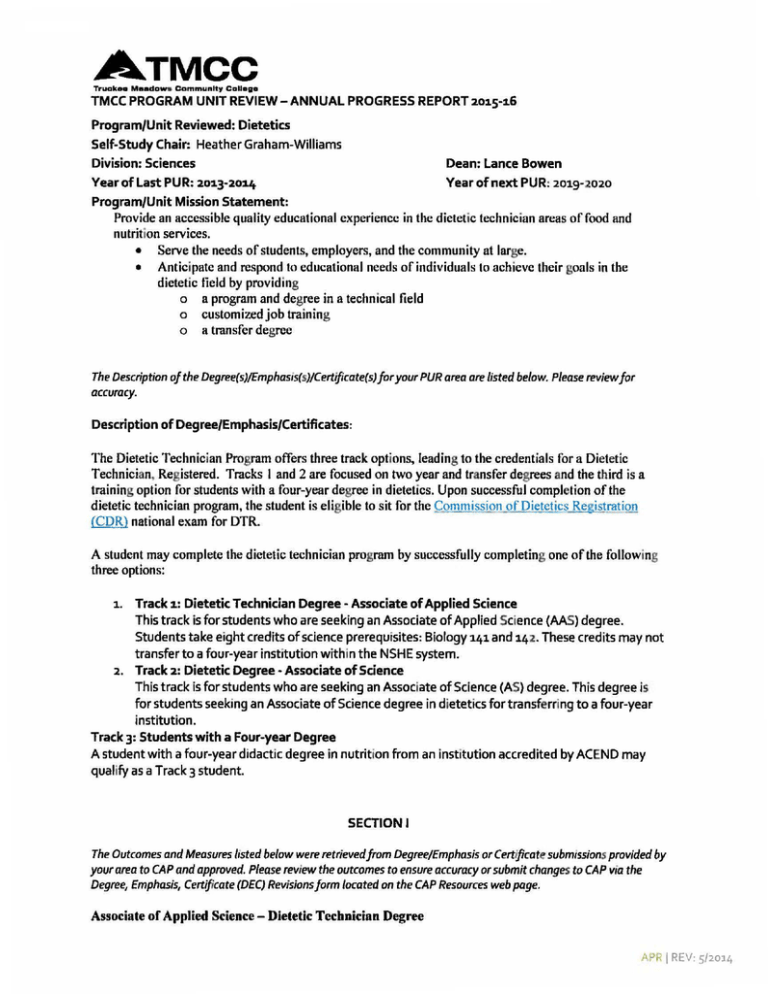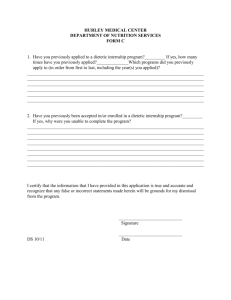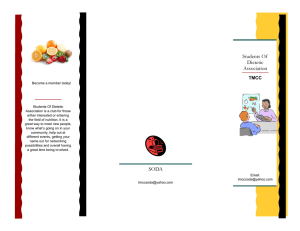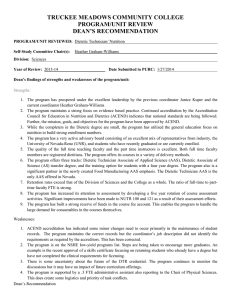ATMCC
advertisement

ATMCC Truck- Meado. . Community cauego TMCC PROGRAM UNIT REVIEW - ANNUAL PROGRESS REPORT 2015-16 Program/Unit Reviewed: Dietetics Self-Study Chair: Heather Graham-Williams Division: Sciences Dean: Lance Bowen Year of Last PUR: 2013-2014 Vear of next PUR: 2019-2020 Program/Unit Mission Statement: Provide an accessible quality educational experience in the dietetic technician areas of food and nutrition services. • Serve the needs of students, employers, and the community at large. • Anticipate and respond to educational needs of individuals to achieve their goals in the dietetic field by providing o a program and degree in a technical field o customized job training o a transfer degree The Description of the Degree(s)/Emphasis(s)/Certificate(s) for your PUR area are listed below. Please reviewfor accuracy. Description of Degree/Emphasis/Certificates: The Dietetic Technician Program offers three track options, leading to the credentials for a Dietetic Technician, Registered. Tracks I and 2 are focused on two year and transfer degrees and the third is a training option for students with a four-year degree in dietetics. Upon successful comple tion of the dietetic technician program, the student is eligible to sit for the Commission of Dietetics Registi:ation (CDR) national exam for DTR. A student may complete the dietetic technician program by successfully completing one of the follow ing three options: 1. Track 1 : Dietetic Technician Degree - Associate of Applied Science This track is for students who are seeking an Associate of Applied Science (AAS) degree. Students take eight credits of science prerequisites: Biology 141and142. These credits may not transfer to a four-year institution within the NSHE system. 2. Track 2: Dietetic Degree - Associate of Science This track is for students who are seeking an Associate of Science (AS) degree. This degree is for students seeking an Associate of Science degree in dietetics for transferring to a four-year institution. Track 3: Students with a Four-year Degree A student with a four-year didactic degree in nutrition from an institution accredited by ACEND may qualify as a Track 3 student. SECTION I The Outcomes and Measures listed below were retrieved from Degree/Emphasis or Certificate submissions provided by your area to CAP and approved. Please review the outcomes to ensure accuracy or submit changes to CAP via the Degree, Emphasis, Certificate (DEC) Revisions form located on the CAP Resources web page. Associate of Applied Science - Dietetic Technician Degree APR I REV· 5/2014 ATMCC Truck•• M••dowa Commun ity Coll•g• TMCC PROGRAM UNIT REVIEW-ANNUAL PROGRESS REPORT 2015-16 Outcome #1: Demonstrate application of theoretical and practical foundations to be adequate ly prepared as entry-level dietetic technician practitioners. Scores on students' first attempt for the national credentialing exam for Dietetic Technician, Registered (DTR), will be evaluated to measure adequate preparation. Outcome#l: Demonstrate academic and practical knowledge of standards appropriate to dietetic practice. Students will demonstrate application of the foundational knowledge and skills appropriate to dietetics practice as measured during and upon completion of their internships by evaluations from dietetic professionals in a variety of health care settings. Outcome#3: Be eligible to take the national credentialing exam for Dietetic Technician, Registered. Students will obtain a verification statement upon graduation for the national licensing exam as measured by yearly review of databases of exam applicants and candidates. Associate of Science - Dietetic Degree Outcome #1: Demonstrate a basic knowledge of nutrition, science, and math that comprise the integral foundation applicable to a four-year degree. Students graduating with the Associate of Science-Dietetic Degree will be qualified to continue on to other NSHE dietetic programs at a junior level as measured by acceptance into those programs. Outcome#l: Synthesize and apply nutrition principles in a variety of settings. Students graduating with the Associate of Science-Dietetic Degree will demonstrate their understanding of nutrition principles by successfully completing the degree as measured by annual review of graduation rates for Dietetic Degree declared majors. Outcome#3: Demonstrate academic and practical knowledge of standards appropriate to dietetic practice. Students will demonstrate application of the foundational knowledge and skills appropriate to dietetics practice as measured during and upon completion of dietetic technician internships by evaluations from dietetic professionals in a variety of health care settings. APR I REV. 5/2014 ATMCC Truak•• M••dowa community coll•g• TMCC PROGRAM UNIT REVIEW -ANNUAL PROGRESS REPORT 2015-16 SECTION 11 The following recommendations and strategies were identified in your most recent Program/Unit Review. Please respond to the strategies by including the status, actions taken to respond to the strategy, projected timeline, and if resource issues are antidpated to fulfill the strategy. Unit Strategy #1 In Fall 20 I 4, develop an aggressive advising and recruitment plan that builds the value of the degree or certificate. Status: Ongoing Timeline: Fall 20152016 Action: In Fall 20 I 4 the Program Coordinator began actively advising and recruiting students from two of the primary transfer courses that she teaches (NUTR 220 and 22 I) to reinforce the value of the degrees and tracks offered. Review of the degrees and career opportunities in the field of dietetics are described in the courses. Many are transfer students who plan to continue onto a four year institution; as the instructor for these courses, the Program Coordinator advises students to earn the AS degree in dietetics. We had 6 graduates as of fall 2014 and JO as offall 2015. Increasing the AS graduates, regardless of whether students complete the dietetic technician component is a major focus. We currently have 80 students in the major (AAS and AS) and the pass rate on the credentialing exam to become a Dietetic Technician, Registered has ranged from 80-100%, up from 71 % in 2013. This is an ongoing strategy that will continue. While we have the Track 3 certificate in place, this has not been a popular option for many students, partially due to the fact that those with a four-year degree are automatically eligible to take the board exam to test for the credential of a Dietetic Technician, Registered (now tenned the Nutritionist Dietetic Technician, Registered or NDTR) and because we have limited internship site space and priority goes to the AS and AAS majors. Anticipated resources needed: N/A Unit Strategy #2 Status: choose Timeline: Ongoing In Fall 2014, utilize the Advisory Board to explore the feasibility of and Fa/12015implementation of state credential (l icensing) changes and job requirement 2016 uol?.rades to add value to the AAS degree. Action: The Advisory Board meets regularly each semester to discuss updates to the program and DTR credentials, including upcoming 2017 proposed changes to all dietetics credentials as per the Commission on Dietetic Registration (CDR). Members of the board include employers and internship sites; they provide updates to position posting and job requirements. This is an ongoing strategy that will continue as it is critical that the program follows profession trends and rules set by the CDR. Discussion of updates occurs at each board meeting and the Coordinator stays current with ACEND and CDR with membership on their Program Director portal as well as attending the annual Nutrition and Dietetics Educator and Preceptors (NDEP) meeting where ACEND and CDR representatives provide updates. Anticipated resources needed: N/A Unit Strategy #3 Status: Timeline: Improve one-on-one advising of students with a focus on program Ongoing Fal/ 2 01 5completion. 2016 Action: In Fall 2014 the Program Coordinator began actively advising and recruiting students from two of the primary transfer courses that she teaches (NUTR 220 and 221) to reinforce the value of the degrees and tracks offered. Review of the degrees and career opportunities in the field o f dietetics are described in the courses. This is an ongoing strategy that will continue, which captures a key group of students each semester. The Program Coordinator has increased enrollment in these courses over the past ten years from less than 20 to up to 40 students each semester. We also work closely with the UNR Dietetic professors to ensure common course content to meet accreditation standards for both two-year and four-year students. This includes complementing schedules to accommodate students at both institutions. This is an ongoing strategy that will continue. Anticipated resources needed: N/A Status: Time line: Unit Strategy #4 Recruit students who are not accepted into the nursing or other allied health Ongoing Fall 2015programs more a1?.1?.ressive ly to offer them an alternate pathway to APR I REV: 5/2014 ATMCC TMCC PROGRAM UNIT REVIEW -ANNUAL PROGRESS REPORT 2015-16 employment in health care. 2016 Action: Recruiting students from these groups is challenging needs improvement in the ability to track students. We know some students do move over to the dietetic and/or technician track. However, many in these other majors have adequate pre-requisites to complete a Community Health Science degree, rather than dietetics. This is an ongoing strategy that will continue and we will explore ways in which we can make recruiting improvements. Anticipated resources needed: N/A Unit Strategy #s Status: choose Timeline: Explore development of technical education tracks in WCSD high schools Ongoing Fa/12015that could build the AAS degree. 2016 Action: The Program Coordinator served on the curriculum development team for the Nevada Department of Education as a question writer and reviewer Foods & Nutrition Assessment for Career and Technical Education (CTE). The program participates in the Fall Success Fair each year to promote the program. Also, the program will participate in the 8th annual Operation 1lcalth Care Bound event in which TMCC has partnered with High Sierra AHEC and Washoe County School District to host the event for - I 000 students on January 15th, 2016. This is an ongoing strategy that will continue. Anticipated resources needed: N/A APR I REV: 5/2014 ATMCC Truell. . M•8dowa Cammunlty CaQeg• TMCC PROGRAM UNIT REVIEW-ANNUAL PROGRESS REPORT 2015-16 SECTION Ill (OPTIONAL- Fill out only if adding new Unit Strategies) Please include any newlv identified Strategies for the Program/Unit. Please respond to the strategies by including the status, actions taken to respond to the strategy, projected timeline, and ifresource issues are anticipated to fulfill the strategy. If there are no new strategies, please leave this blank and no signatures are required. Unit Strategies: New Status: choose Ongoing Complete Other Timeline: Date range Action: Recap of accomplishments work to do Anticipated resources needed: What are they and what are the approximate costs. Unit Strategies: New Status: choose Ongoing Complete Other Action: Recap of accomplishments work to do Anticipated resources needed: What are they and what are the approximate costs. Unit Strategies: New Status: choose Ongoing Complete Other Action: Recap of accomplishments work to do Timeline: Date range Timeline: Date range Anticipated resources needed: What are they and what are the approximate costs. Approvals (Signatures and dates are required) APf.< I REV: 5/2014


